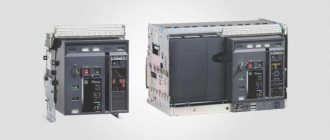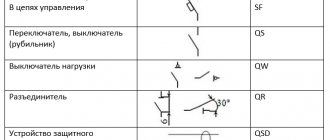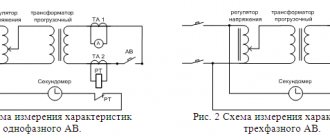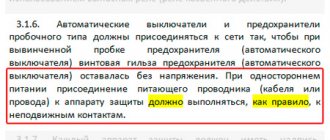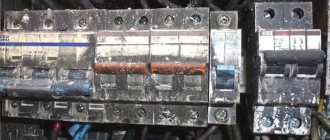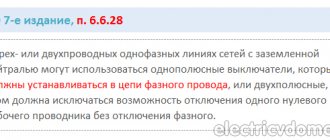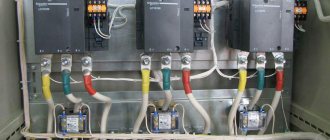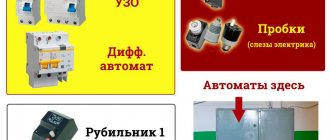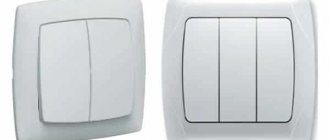The existence of modern man is no longer possible without electricity. Each house, apartment, and production facility is equipped with different equipment. Rarely do property owners think about how much electricity is consumed in total - calculations are made only during the initial installation of electrical wiring. But if the network voltage is exceeded, a short circuit will occur and the network will fail. To prevent such situations, a circuit breaker is used. For domestic needs this is a 16 amp machine.
Modular automatic machine C16
Modular automatic machine C16
The device is designed to protect power networks and connected equipment from overloads, failures, and voltage surges. A 16A automatic machine can be purchased at any electrical store; prices vary - they depend on the main characteristics of the device, the number of working poles, and the recognition of the manufacturer. The main indicator of cost is the value of the breaking capacity of the device and its switching value.
The C16 automatic machine is called modular due to certain qualities. Each of the poles of the device is presented in the form of a separate standard module, that is, multipolar devices are made from several separate single blocks (modules). Accordingly, such a 16-amp machine has a different body structure and assembly format. For example, in a molded box the device is presented as a single monolithic device - it cannot be disassembled, unlike other models.
Cable cross-section for machine s16
In residential buildings, as a rule, a single-phase network is used. Therefore, wiring is chosen with 2 or 3 cores. Their cross-sectional diameter must correspond to the installed 16-amp electric machine. The maximum permissible diameter is 25 square meters. mm, but the indicator also depends on the metal of which the cable is composed. Here is their comparative characteristics:
Metal in wires
| Criterion | Aluminum wire | Copper wire |
| Cross section | From 2.5 sq. mm | From 0.35 sq. mm |
| Current conductivity | Up to 3 kW at minimum cross-section | The figure is approximately 1.6 times higher |
| Life time | 15-20 years | About 50 years |
| Strength | The wire breaks easily when bent | Due to the plasticity of the metal, the wiring can be laid at any angle. The fragility index for the same cross-section is 2-3 times lower. |
| Ease of installation | To power a modern outlet, you need a wire with a cross-section of 4 square meters. mm. The built-in terminals have a tolerance of 3 mm. That is, a connection with a nominal value of 16A is excluded. | For a similar task (16A socket), a cable with a core cross-section of 1.5-2.5 square meters is required. mm. That is, there are no difficulties during installation. |
| Oxidation | The area with missing insulation quickly oxidizes. The resistance provided by the film reduces the permissible load on the contacts. Therefore, a special quartz-vaseline paste is used. | Patina conducts current well, so it does not affect the resistance of joints. |
You might be interested in: Design and principle of operation of a frequency converter
Terminals in socket
Despite the noticeable difference in the cost of materials (aluminum wiring is 2-3 times cheaper), most cables are laid using copper cable. When choosing the cross-section of the cores, they rely on the nature of the machine and the method of placing the wires.
For a 16A protective device, the copper core must have a cross-section of 2.5 square meters. mm. This corresponds to its maximum voltage of 21A in a walled position, 30A in an open position (it is in contact with the external environment, which means it easily gives off heat when heated).
If you take a wire with a cross section of 1.5 sq. mm, then within an hour it will overheat and fail. This is justified by the maximum permissible current of 18 A.
Installation inside and outside walls
General characteristics of the C16 circuit breaker and markings
The 16A difavtomat, regardless of the number of working poles, is determined by several general characteristics. You can find out what indicators the device has from the labeling. Designations are applied to the product body in the following order:
- rated current;
- time-current restrictions within which the mechanism operates;
- rated breaking capacity;
- current-limiting class of the model.
Based on the specified data, the power in kW of the C16 machine, productivity, speed and other parameters are determined.
Rated current
You can find out the conditional value of the passing current of a 16A machine from the name of the device - 16 Amperes. This means that the mechanism will continue to operate uninterruptedly until the passing current exceeds 16A.
An equally important criterion is the ambient temperature. For normal operation it should not be higher than 30° Celsius. Otherwise, the machine will turn off at lower voltage. If the air is cold, the nominal value will, on the contrary, increase.
Switching or breaking capacity
This characteristic allows you to understand at what short circuit strength the 16A single-pole and multi-pole circuit breaker will operate. When disconnected, the device should remain operational - when switched to the initial position, the device can be used again. The permissible current strength is marked in a rectangular frame on the mechanism body. On production models they are sometimes left without a frame and placed separately.
The designation consists of several numbers and the letter “A”. For domestic needs, devices of the 4500 or 6000 A class are suitable. For industrial needs, more powerful ones are used. The higher the value, the greater the product price and reliability.
Current limiting class
This characteristic of the differential machine 16A shows the time during which the arc is extinguished in full. There are three classes of current limitation of circuit breakers. The third class shows that the arc is extinguished in 3-5 milliseconds. In turn, with the second class, the arc is extinguished in 5-10 milliseconds. There are no restrictions for the first class; extinction occurs in 10 milliseconds or more.
The designation is located on the body - a square-shaped frame, inside there is a number 2 or 3. It is usually located under the switching capacity marking of the mechanism or next to it (depending on the model). If there are no marks, then the machine is 16A of the first class of current limitation.
Time-current characteristics
Each 16A circuit breaker has two different releases - a metal plate (thermal version) and a current limit relay (electromagnetic version). Thanks to these elements, the electrical circuit breaks. The first is intended for situations in which the power supply load is exceeded. The second is for short circuits. If the opposite happens, then the C16 circuit breaker is not selected correctly. It is necessary to reassess the power of the electrical network and the capabilities of the device to prevent emergency situations.
Time-current characteristics are the ratio of current strength and time at which automatic shutdown and disconnection of the circuit occurs. It is marked in the device name with the letter “C” (in this case, before the number 16).
The greater the current passing, the higher the load of the 16A machine. Excessive values lead to damage to cables, wires, and electrical components. Therefore, the task of such machines is to disconnect from the power supply circuit until the moment when the power exceeds the permissible limit and damages the equipment (in most cases irreversibly).
The time-current characteristics of the thermal release for the C16 automatic device range from 1.13 to 1.45 In. When a current equal to 1.13 of the rated current passes through the thermal release of the C16 circuit breaker, shutdown occurs in an hour or more. During the passage of 1.45 of the rated current, it will turn off in less than 60 minutes.
When the current increases by more than 23.2 Amperes, the shutdown time of the machine will decrease. If the current reaches values sufficient to turn off the electromagnetic release, this release will turn off the machine.
A special rule applies for an electromagnetic contact - a shutdown occurs when the power of electricity passing through the machine increases 5 times at a time (for example, a voltage drop). Time – a little more than 0.1 sec. If the surge is reflected in the passing current exceeding 10 times, the machine will operate faster than 0.1 seconds.
Cable cross-section for automatic machine C16
The size of the wire diameter for a C16 machine depends on the power it is designed for and the established time-current characteristics. For example, if the device passes 18 Amps within an hour, the cross-section should not be less than 0.25 centimeters square. Material: copper. If aluminum is used, it is necessary to use cables with a larger cross-section for the same load. In poor conditions, such a wire can withstand up to 25 Amps.
The conductivity of the cable and compatibility with a single-pole or multi-pole 16A circuit breaker depends on the number of cores, the insulation pad and the conditions under which the wire is laid and operated.
A current of 23.2 Amperes can flow through the c16 circuit breaker for an hour. Such a current, under unfavorable circumstances, approaches the dangerous limit for a copper conductor with a cross-section of 2.5 mm². This is harmful to the cable. However, the conductor will be able to withstand such current for a short time. Such an increase in current should not be a frequent occurrence.
There is no need to overload the machine and the cable by connecting too much load, otherwise the cable will quickly become unusable due to constant overheating.
Other characteristics
Table for selecting machines by power
Individual parameters vary depending on the number of phases of the current-carrying circuit and electrical wiring - the maximum voltage and power of the load passed. For a single-phase network, where single-pole or double-pole C16 circuit breakers are used, the characteristics have certain values. For a three-phase network, where three-pole or four-pole C16 circuit breakers are used, these characteristics will be different. The equipment connection diagram is also changing.
Single-pole and double-pole devices are used in single-phase electrical networks. Three-pole and four-pole - in three-phase. Sometimes bipolar ones are used in two-phase networks. They are usually absent in everyday life. An exception may be ungrounded outputs of a single-phase generator and isolating transformer.
Single-pole and three-pole circuit breakers disconnect the phase conductors, and leave the zero conductor intact. Two-pole and four-pole circuit breakers open both the phase and neutral conductors at the same time.
There are two types of two-pole circuit breakers - 2p and 1p+n. Double-pole 2p circuit breakers consist of two identical single-pole devices connected mechanically. In this case, both poles are protected.
Two-pole 1p+n consist of a single-pole mechanism and a single-pole switch, also mechanically connected, that is, the pole that opens the neutral conductor does not contain automatic releases, but only a mechanism that opens the contacts. The microcontacts are separated using a mechanical drive when the machine that opens the phase conductor is turned off, and the n pole has no protection.
Four-pole 4p devices consist of four full-fledged single-phase 16A circuit breakers, and 3p+n devices consist of three single-pole ones and the same switch.
Marking
The average person pays attention only to the brand name and amperage, which the manufacturer applies to the body using laser technology or indelible paint. For professionals, all indicators are important. Depending on the machine, the number of characteristics may vary.
Marking
This is what is hidden under the numbers and letters on the front side:
- ABB, IEK, Legrand - manufacturer's logo.
- S, SH, Acti, Easy, BM, TX - linear series of modular products. The letter may be followed by various numbers.
- 6, 10, 16 and more - the maximum current value at which the circuit does not open. It is worth noting that the indicator is relevant at a temperature of +30 degrees Celsius. The product is triggered by an overload of 13-55%. If it is colder, the machine will turn off at a higher load, and vice versa in the heat.
- 230V, 400V - network voltage (single-phase or three-phase) at which use is allowed.
- 4500, 6000 or 10000 is the limit (switching capacity) at which tripping occurs during a short circuit. In this case, the device does not fail. If a short circuit occurs with a value exceeding the value, the magnetic release will not cope with it and the device will burn out. The indicator is enclosed in a rectangle.
You might be interested in Features of an electrical energy generator
Short circuit limits
- 1, 2 or 3 next to the short circuit - an indicator of the speed of extinguishing the electric arc (from 10 ms, from 6 ms and from 2.5 ms, respectively). During a short circuit, the conductors heat up, which affects the insulation. The faster the machine works, the more intact the wiring and the device itself will be. The first class is usually not indicated.
- B, C, D, K, Z before amperage - time for automatic shutdown of the device in the event of a short circuit or overload in the network. In everyday life, products with characteristics of type C are more often used, less often B and D. For example, C16 will turn off at 80-160A, and B16 at 46-80A. That is, the second one will work later. The difference is in fractions of a second.
- Wave or straight line - can be used in AC or DC voltage networks. These marks are located next to the rated voltage.
Voltage
- 50/60 Hz - frequency of oscillations in the network. The indicator is not always indicated, since most household appliances operate in one mode.
- Connection diagram. 1, 3, 5 and 2, 4, 6 - upper (supply) and lower (loaded) contacts. N - pole for connecting the neutral core.
On the side plane it is indicated:
- GOST or IEC/EN - compliance with standards (Russian or international).
- U is the operating voltage.
- Icn is the maximum breaking capacity value.
- I—electromagnetic shutdown limit.
- Uimp is the impulse withholding voltage.
- Ui is the insulation voltage.
- Deg is the degree of pollution, which depends on moisture condensation.
- Cat - application category regarding selectivity.
- Barcode or QR code is information about a product that, when read by a special device, is obtained on the trading platform.
Bar code
In addition, the manufacturer indicates the tightening torque, number of poles, and type of release. Differential machines have additional markings.
Where is the C16 assault rifle used?
For domestic use, the device is suitable as an input device installed in front of the meter. In this case, the number of poles depends on the number of phases and the requirements that are developed by the energy management organization.
For individual electrical devices, it is permissible to install machines on one pole.
It is necessary to take into account how many kilowatts a 16-amp machine holds and how much the device consumes. It is better to choose protection with indicators higher than that of the equipment.
Connection diagram
Connection diagram without grounding
According to the PUE, the supply conductor is connected to a fixed microcontact. This means connecting from above (there may be exceptions). You need to look at the connection diagram located on the device body. The designations are as follows:
- symbol 1 in the diagram shows where the input of the first phase conductor is connected;
- 2 - shows the output of the first phase conductor;
- 3 – entrance;
- 4 – output for a two-pole device;
- 5 – entrance;
- 6 – three-pole output;
- 7 – entrance;
- 8 – four-pole output.
If, in addition to the numbers on the diagram and contacts, there is a designation of the letter N , the neutral conductor is connected here. When there is no such symbol, zero is connected to the terminals indicated by the maximum numbers. If the phase conductors are connected from above, then so is the zero. If the phase conductors are connected from below, the neutral one is also connected from below.
The c16 automatic machine is very rarely used in everyday life as an introductory one. There are similar requirements from electricity supply companies. When connecting, it is impossible to maintain selectivity even with respect to the thermal release, which means that in any emergency the input circuit breaker will be turned off or both at once.
Manufacturing companies
The modular automatic machine from foreign brands of the household series meets the standards for automatic machines in everyday life. But industrial ones are of better quality, more reliable and easier to install. The most famous include:
- foreign - ABB, Schneider Electric, Legrand;
- Russian - KEAZ, IEK, EKF.
Modular devices from domestic companies are made in China, although this is not a sign of their unreliability. The quality is slightly worse than household series from foreign manufacturers. They cost less. Also meets the standards for household machines. Usually they do not have series similar to industrial complexes of foreign companies.
RCD and additional devices
You should not consider the machine separately from other components of the electrical panel. When buying a device, you need to understand that it will be mounted together with an RCD. It is better to use an RCD from the same manufacturer with the machine and from the same series. At the same time, you can be absolutely sure of their best interaction.
RCDs made by domestic manufacturers are inferior in quality to foreign ones. They often do not have electromechanical RCDs in the series, but have less variety in characteristics.
To determine which machine should be installed, it is necessary to take into account many different parameters. The C16 automatic machine is one of the most commonly used in everyday life. The power will allow you to protect equipment, a small number of standard devices.
16 amp machine: technical specifications, connection diagram and markings
The existence of modern man is no longer possible without electricity. Each house, apartment, and production facility is equipped with different equipment. Rarely do property owners think about how much electricity is consumed in total - calculations are made only during the initial installation of electrical wiring. But if the network voltage is exceeded, a short circuit will occur and the network will fail. To prevent such situations, a circuit breaker is used. For domestic needs this is a 16 amp machine.
Modular automatic machine C16
The device is designed to protect power networks and connected equipment from overloads, failures, and voltage surges. A 16A automatic machine can be purchased at any electrical store; prices vary - they depend on the main characteristics of the device, the number of working poles, and the recognition of the manufacturer. The main indicator of cost is the value of the breaking capacity of the device and its switching value.
The C16 automatic machine is called modular due to certain qualities. Each of the poles of the device is presented in the form of a separate standard module, that is, multipolar devices are made from several separate single blocks (modules). Accordingly, such a 16-amp machine has a different body structure and assembly format. For example, in a molded box the device is presented as a single monolithic device - it cannot be disassembled, unlike other models.
General characteristics of the C16 circuit breaker and markings
The 16A difavtomat, regardless of the number of working poles, is determined by several general characteristics. You can find out what indicators the device has from the labeling. Designations are applied to the product body in the following order:
- rated current;
- time-current restrictions within which the mechanism operates;
- rated breaking capacity;
- current-limiting class of the model.
Based on the specified data, the power in kW of the C16 machine, productivity, speed and other parameters are determined.
Rated current
You can find out the conditional value of the passing current of a 16A machine from the name of the device - 16 Amperes. This means that the mechanism will continue to operate uninterruptedly until the passing current exceeds 16A.
An equally important criterion is the ambient temperature. For normal operation it should not be higher than 30° Celsius. Otherwise, the machine will turn off at lower voltage. If the air is cold, the nominal value will, on the contrary, increase.
Switching or breaking capacity
This characteristic allows you to understand at what short circuit strength the 16A single-pole and multi-pole circuit breaker will operate. When disconnected, the device should remain operational - when switched to the initial position, the device can be used again. The permissible current strength is marked in a rectangular frame on the mechanism body. On production models they are sometimes left without a frame and placed separately.

